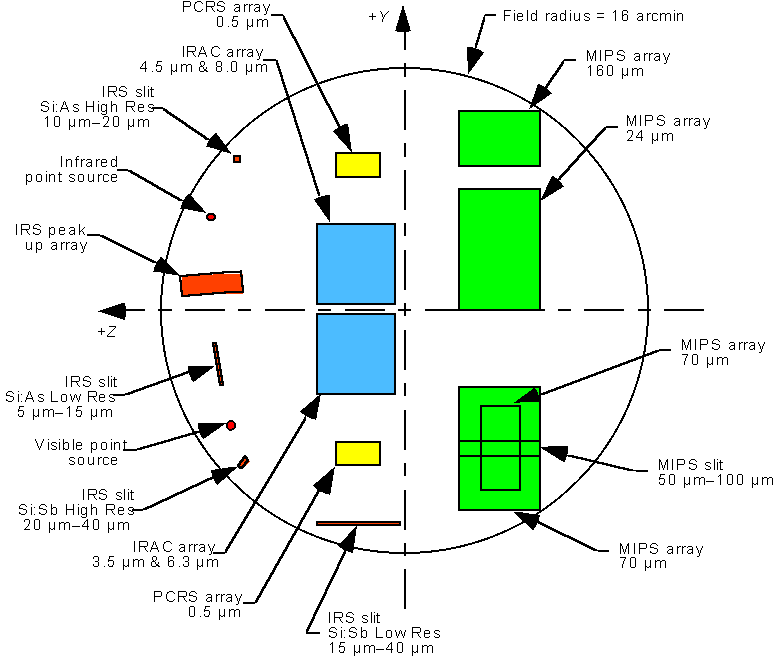
The Space Infrared Telescope Facility, SIRTF, currently scheduled for launch in December 2001, is the fourth and last of the NASA "Great Observatory" series. Previous members of the family were the Hubble Space Telescope (covering the ultraviolet, optical, and near infrared, launched in April 1990), the Compton Gamma-Ray Observatory (covering energies from about 10 keV to a few GeV, launched in April 1991), and the Advanced X-Ray Astrophysics Facility (AXAF, covering X rays with energy < 10 keV; currently at the Cape for launch in January 1999. AXAF was discussed here last August).
While it must seem old hat to most ASSA members, it needs to be
repeated often for the benefit of puzzled newcomers
that all these different "astronomies", optical, UV, infrared, submillimeter,
X-ray, radio, gamma-ray, on and on seemingly without end,
are essentially looking at light.
The only physical difference in the radiation is in the
frequency, or number of vibrations per second.
All light in turn
is simply an electromagnetic vibration in space, in which a changing
electric field creates a changing magnetic field,
which in turn, with perfect symmetry,
creates a further electric field, all propagating together
as a wave, with a speed c very near 300,000 km per sec in a vacuum.
Since c is a universal and fundamental physical constant,
it follows that the
total of all the waves that go by in one second must fit into this 300,000 km;
and thus the length of each wave (the
Until only about 60 years ago, all we had in astronomy was the visible band, which extends from about 0.4 µm (blue) to about 0.7 µm (red). This is less than one octave, in the terminology we use for music. (One octave on a piano keyboard covers just a factor of two in frequency, so that eg, if Concert A, the A above Middle C, has a frequency of 440 Hz, then next A below that has a frequency of 220 Hz.) Today, from the extremes of 107 Hz at the long wavelength end of the radio to the top around 1015 eV in gamma rays, astronomy spans over 75 octaves in wavelength and frequency. The final essential thing to realize is that the appearance of the sky changes radically with wavelength. Important changes occur in an octave, and in one decade the scene is typically completely transformed. Thus, in a very real sense, we were peering through a keyhole until recently. In barely a lifetime the gate has been opened, to reveal a whole new country.
SIRTF will cover the infrared from 3 µm to 180 µm with an 85 cm telescope featuring a beryllium primary mirror and three advanced liquid He-cooled science instruments for imaging and spectroscopy. The short-wavelength end is about where (2.5 µm) HST's new near-IR camera NICMOS, which is cooled by solid N2, cuts off. The SIRTF long-wavelength limit is near where the existence of effective low-noise electronic amplifiers and oscillators make superheterodyne radio receivers possible.
Early NASA plans for SIRTF in 1990 envisaged a huge 5700 kg observatory with 3800 liters of LHe, to be launched on a Titan, and costing over $2,000 million. It is a credit to the mission designers that, despite the severely constrained NASA budget that has actually become available, the original capabilities have been largely retained in a drastically reduced package. The current baseline is for a < 1000 kg spacecraft with just 360 l of LHe (less than needed for IRAS, the first IR astronomy satellite in 1982), to be launched on a Delta for a total cost of $450 million. One key efficiency has been the move from earth orbit to an orbit around the Sun. The spacecraft will be launched on a slow escape trajectory that will drift away from Earth at about 0.1 AU (15,000,000 km) per year. The removal of the Earth and Moon as heat sources, which need to be excluded from the telescope field of view, resulted in an enormous simplification in thermal design, and in operational complexity. It now appears that the original goal of a 5 year LHe lifetime can be nearly met.
The three instruments included on SIRTF are the InfraRed Array Camera (IRAC, from the Smithsonian Astrophysical Observatory at Harvard), the InfraRed Spectrograph (IRS, from Cornell), the Multiband Imaging Photometer for SIRTF (MIPS, supplied by the University of Arizona). Their sensitivities and
capabilities are generally order-of-magnitude improvements over previously flown instruments. IRAC can do imaging and photometry in four bands between 3.5 and 8 µm. IRS can do either slit spectroscopy from 5 to 40 µm with resolutions of either 50 or 600, or scanning spectroscopy by scanning the slit for fields up to a few arcminutes. MIPS permits large-field or high-resolution imaging in several energy bands from 15 to 160 µm, low-resolution 50-100 µm slit spectrophotometry, and absolute measurements of the brightness of diffuse and extended objects. We will discuss the instruments individually in more detail in a later column, but you can get an idea of the arrangement from the figure ("PCRS" is the Pointing, Calibration, and Reference Sensor) which shows the detectors in the focal plane.
SIRTF entered full-scale development last year, and as I write is undergoing its "Critical Design Review" (CDR), a NASA ritual in which the detailed design of all elements of the complete mission are subject to scrutiny by an independent panel. The process is hierarchical, so that each element of the mission -- the spacecraft, the optical telescope, the separate instruments, the data analysis plans, and so forth, have already passed CDRs to verify their separate readiness to proceed to fabrication and test. The focus of the final top-level CDR is thus on the integrity of the mission, on the ability of the elements to play together to achieve the total of SIRTF's objectives. Overall mission responsibility is at JPL, Lockheed will build the spacecraft, and the Science Support Center and data analysis functions will be at IPAC.